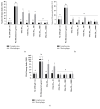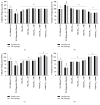Immunotoxicological Evaluation of Schinus molle L. (Anacardiaceae) Essential Oil in Lymphocytes and Macrophages
- PMID: 30410557
- PMCID: PMC6206567
- DOI: 10.1155/2018/6541583
Immunotoxicological Evaluation of Schinus molle L. (Anacardiaceae) Essential Oil in Lymphocytes and Macrophages
Abstract
Schinus molle L. is used to treat various diseases; however, the literature lacks information regarding its possible immunotoxic effects. The aim of the study was to investigate the immunotoxic effects of essential oil from leaves of Schinus molle L. in cultures of human lymphocytes and macrophages. The cultures were treated with essential oil (EO) of Schinus molle L. and subsequently subjected to genotoxic analysis (comet assay), mutagenic analysis (micronucleus frequency and chromosomal aberration), and cytotoxic (cell viability) and functional parameters (interleukins secretions). Our analyses have determined that the essential oil from leaves of Schinus molle L. presents several compounds with α-pinene being the major compound; in addition, the compound verbenene was firstly identified; genotoxic effects were detected only in macrophages and only at the two highest concentrations tested. An important finding is that Schinus molle L. oil causes an activation of the immune system. This action has its mechanism centered by the cascade nitric oxide-interleukin-10-tumor necrosis factor alpha.
Figures




Similar articles
-
Chemical composition and anticancer and antioxidant activities of Schinus molle L. and Schinus terebinthifolius Raddi berries essential oils.J Food Sci. 2010 Aug 1;75(6):C466-72. doi: 10.1111/j.1750-3841.2010.01711.x. J Food Sci. 2010. PMID: 20722898
-
Schinus molle essential oil as a potential source of bioactive compounds: antifungal and antibacterial properties.J Appl Microbiol. 2019 Feb;126(2):516-522. doi: 10.1111/jam.14157. Epub 2018 Dec 26. J Appl Microbiol. 2019. PMID: 30431699
-
Antioxidant, antimicrobial and toxicological properties of Schinus molle L. essential oils.J Ethnopharmacol. 2014;151(1):485-92. doi: 10.1016/j.jep.2013.10.063. Epub 2013 Nov 11. J Ethnopharmacol. 2014. PMID: 24231069
-
Chemical Composition, Antioxidant, Insecticidal Activity, and Comparative Analysis of Essential Oils of Leaves and Fruits of Schinus molle and Schinus terebinthifolius.Evid Based Complement Alternat Med. 2022 May 30;2022:4288890. doi: 10.1155/2022/4288890. eCollection 2022. Evid Based Complement Alternat Med. 2022. PMID: 35677362 Free PMC article.
-
Chemical composition of Schinus molle essential oil and its cytotoxic activity on tumour cell lines.Nat Prod Res. 2008;22(17):1521-34. doi: 10.1080/14786410701848154. Nat Prod Res. 2008. PMID: 19023816
Cited by
-
Much More Than a Pleasant Scent: A Review on Essential Oils Supporting the Immune System.Molecules. 2019 Dec 11;24(24):4530. doi: 10.3390/molecules24244530. Molecules. 2019. PMID: 31835699 Free PMC article. Review.
-
Acute and developmental toxicity of embelin isolated from Embelia schimperi Vatke fruit: In vivo and in silico studies.Toxicol Rep. 2023 Jun 10;10:714-722. doi: 10.1016/j.toxrep.2023.06.006. eCollection 2023. Toxicol Rep. 2023. PMID: 37362226 Free PMC article.
-
Essential Oils as a Feed Additives: Pharmacokinetics and Potential Toxicity in Monogastric Animals.Animals (Basel). 2019 Jun 13;9(6):352. doi: 10.3390/ani9060352. Animals (Basel). 2019. PMID: 31200591 Free PMC article. Review.
-
Exploring the Bioactive Potential and Chemical Profile of Schinus molle Essential Oil: An Integrated In Silico and In Vitro Evaluation.Plants (Basel). 2025 Aug 7;14(15):2449. doi: 10.3390/plants14152449. Plants (Basel). 2025. PMID: 40805798 Free PMC article.
References
-
- Viegas Jr C., Bolzani V. S., Barreiro E. J. Os produtos naturais e a química medicinal moderna. Química Nova. 2006;29(2):326–337. doi: 10.1590/s0100-40422006000200025. - DOI
-
- Maciel M. A. M., Pinto A. C., Veiga V. F., Jr. Medicinal plants: the need for multidisciplinary scientific studies. Química Nova. 2002;25(3):429–438. doi: 10.1590/s0100-40422002000300016. - DOI
-
- Güez C. M., de Souza R. O., Fischer P., et al. Evaluation of basil extract (Ocimum basilicum L.) on oxidative, anti-genotoxic and anti-inflammatory effects in human leukocytes cell cultures exposed to challenging agents. Brazilian Journal of Pharmaceutical Sciences. 2017;53(1)
LinkOut - more resources
Full Text Sources

